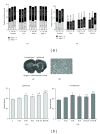Motor Skill Training Promotes Sensorimotor Recovery and Increases Microtubule-Associated Protein-2 (MAP-2) Immunoreactivity in the Motor Cortex after Intracerebral Hemorrhage in the Rat
- PMID: 23956876
- PMCID: PMC3727191
- DOI: 10.1155/2013/159184
Motor Skill Training Promotes Sensorimotor Recovery and Increases Microtubule-Associated Protein-2 (MAP-2) Immunoreactivity in the Motor Cortex after Intracerebral Hemorrhage in the Rat
Abstract
Motor skill learning may induce behavioral and neurophysiological adaptations after intracerebral hemorrhage (ICH). Learning a new motor skill is associated with dendritic reorganization and requires protein synthesis and expression of MAP-2. The purpose of this study was to evaluate motor performance and expression of MAP-2 in the motor cortex of rats submitted to intracerebral hemorrhage model (ICH) and skill task training (SK) or unskilled training (US) during 4 weeks. The Staircase test was used for behavioral evaluation, and relative optical densities and morphometrical analysis were used to estimate MAP-2 immunoreactivity and parameters of brain tissue in both motor cortices. Results show that skill task training performed with the impaired forelimb was able to increase MAP-2 immunoreactivity in the motor cortex either in sham or in ICH groups in both cortices: ipsilesional [F (5,35) = 14.25 (P < 0.01)] and contralesional hemispheres [F (5,35) = 9.70 (P < 0.01)]. ICH alone also increased MAP-2 immunoreactivity despite the absence of functional gains. Behavioral evaluation revealed that ICH-SK group performed better than ICH and ICH-US animals in the Staircase test. Data suggest that motor skill training induces plastic modifications in both motor cortices, either in physiological or pathological conditions and that skill motor training produces higher brain plasticity and positive functional outcomes than unskilled training after experimental intracerebral hemorrhage.
Figures

Similar articles
-
Skilled reaching training promotes astroglial changes and facilitated sensorimotor recovery after collagenase-induced intracerebral hemorrhage.Exp Neurol. 2011 Jan;227(1):53-61. doi: 10.1016/j.expneurol.2010.09.009. Epub 2010 Sep 17. Exp Neurol. 2011. PMID: 20850433
-
Motor Skills Training Improves Sensorimotor Dysfunction and Increases Microtubule-Associated Protein 2 mRNA Expression in Rats with Intracerebral Hemorrhage.J Stroke Cerebrovasc Dis. 2016 Aug;25(8):2071-7. doi: 10.1016/j.jstrokecerebrovasdis.2016.05.007. Epub 2016 Jun 2. J Stroke Cerebrovasc Dis. 2016. PMID: 27265094
-
Motor skills training promotes motor functional recovery and induces synaptogenesis in the motor cortex and striatum after intracerebral hemorrhage in rats.Behav Brain Res. 2014 Mar 1;260:34-43. doi: 10.1016/j.bbr.2013.11.034. Epub 2013 Dec 1. Behav Brain Res. 2014. PMID: 24304717
-
Integrated technology for evaluation of brain function and neural plasticity.Phys Med Rehabil Clin N Am. 2004 Feb;15(1):263-306. doi: 10.1016/s1047-9651(03)00124-4. Phys Med Rehabil Clin N Am. 2004. PMID: 15029909 Review.
-
Motor training induces experience-specific patterns of plasticity across motor cortex and spinal cord.J Appl Physiol (1985). 2006 Dec;101(6):1776-82. doi: 10.1152/japplphysiol.00515.2006. Epub 2006 Sep 7. J Appl Physiol (1985). 2006. PMID: 16959909 Review.
Cited by
-
Rehabilitation following hemorrhagic stroke: building the case for stroke-subtype specific recovery therapies.F1000Res. 2017 Nov 23;6:2044. doi: 10.12688/f1000research.11913.1. eCollection 2017. F1000Res. 2017. PMID: 29250322 Free PMC article. Review.
-
Motor Rehabilitation Provides Modest Functional Benefits After Intracerebral Hemorrhage: a Systematic Review and Meta-Analysis of Translational Rehabilitation Studies.Transl Stroke Res. 2025 Apr;16(2):484-511. doi: 10.1007/s12975-023-01205-w. Epub 2023 Nov 20. Transl Stroke Res. 2025. PMID: 37981635 Free PMC article.
-
Recovery and Rehabilitation after Intracerebral Hemorrhage.Semin Neurol. 2016 Jun;36(3):306-12. doi: 10.1055/s-0036-1581995. Epub 2016 May 23. Semin Neurol. 2016. PMID: 27214706 Free PMC article. Review.
-
Targeted Vagus Nerve Stimulation for Rehabilitation After Stroke.Front Neurosci. 2019 Mar 29;13:280. doi: 10.3389/fnins.2019.00280. eCollection 2019. Front Neurosci. 2019. PMID: 30983963 Free PMC article. Review.
-
Enhancing Rehabilitative Therapies with Vagus Nerve Stimulation.Neurotherapeutics. 2016 Apr;13(2):382-94. doi: 10.1007/s13311-015-0417-z. Neurotherapeutics. 2016. PMID: 26671658 Free PMC article. Review.
References
-
- World Health Organization. Global burden of neurological disorders: estimates and projections. Neurological Disorders: Public Health Challenges. 2006:27–39.
-
- Xi G, Keep RF, Hoff JT. Mechanisms of brain injury after intracerebral haemorrhage. Lancet Neurology. 2006;5(1):53–63. - PubMed
-
- Auriat AM, Grams JD, Yan RH, Colbourne F. Forced exercise does not improve recovery after hemorrhagic stroke in rats. Brain Research. 2006;1109(1):183–191. - PubMed
-
- Levin MF, Kleim JA, Wolf SL. What do motor “recovery” and “compensationg” mean in patients following stroke? Neurorehabilitation and Neural Repair. 2009;23(4):313–319. - PubMed
-
- MacLellan CL, Keough MB, Granter-Button S, Chernenko GA, Butt S, Corbett D. A critical threshold of rehabilitation involving brain-derived neurotrophic factor is required for poststroke recovery. Neurorehabilitation and Neural Repair. 2011;25(8):740–748. - PubMed
LinkOut - more resources
Full Text Sources
Other Literature Sources

